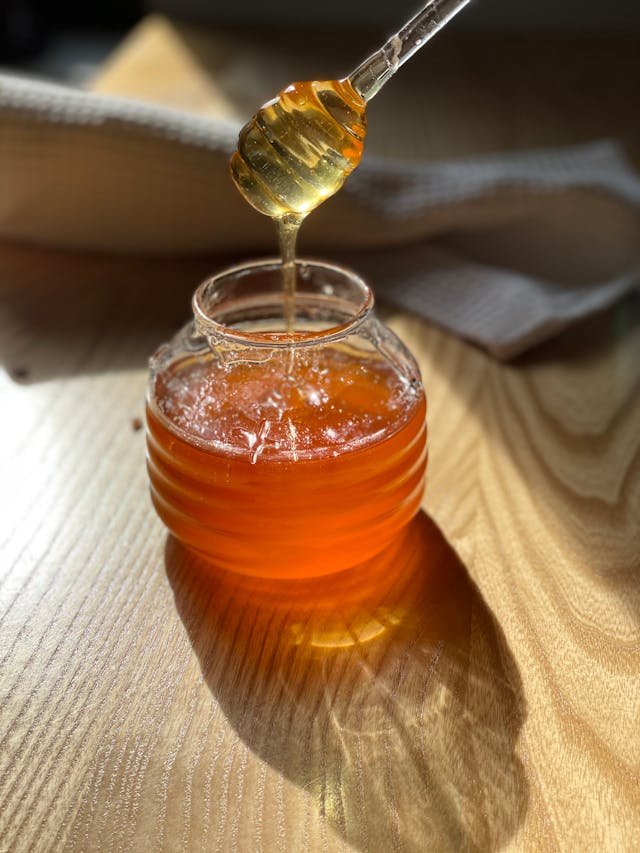Hey honey lovers , welcome to the page. Imagine a golden flow of liquid sunlight over your morning toast, each drop carrying the soul of countless bee flowers from vast North American landscapes. This is the magic of North American honey—more than just a sweetener, it is a symbol of nature’s reward and a testimony to the dance between bees and flowers. In this blog post, we will explore on a journey to uncover the rich history, different varieties, and huge benefits of North American honey. You’ll learn about the wonderful process of honey production, the unique flavors from different regions, and why this natural treasure is a basic part in kitchens and medicine cabinets alike. Get ready to explore the world of North American honey, where every jar tells a story of tradition, sustainability, and delicious, wholesome goodness.
Origin
The story of North American honey is deeply related with the rich histories of the United States and Canada. Long before European settlers arrived, Indigenous peoples across North America had been harvesting honey from wild bees and using it for both cooking and medicinal purposes. The arrival of European settlers in the 1600s marked a significant turning point, as they brought with them the European honeybee , which quickly adjusted to the different climates and landscapes of the continent.
In the United States, beekeeping became an essential agricultural practice, especially as innovation moved west. The fertile lands and abundant wildflowers of the Midwest side soon became renowned for producing high-quality honey. Similarly, in Canada, the vast expanses of untouched wilderness and grasslands provided an ideal environment for beekeeping, contributing to an expanding honey industry.
Throughout the 19th and 20th centuries, advancements in beekeeping techniques and transportation allowed for the commercialization of honey production. Today, North American honey is celebrated for its variety and quality, with each region offering unique flavors and characteristics. From the plant fields of the Midwest to the wildflower grass of Canada, North American honey is proof of the continent’s natural diversity and the relationship between humans and bees.
Types of Honey Found in North America

North America offers a rich variety of honey types, each influenced by the specific flora and environmental conditions of its region. Here are some famous types of honey, along with the countries where they are frequently produced:
Wildflower Honey (USA, Canada, Mexico)
Wildflower honey is made from the nectar of various types of flowers. Its taste and color can vary widely depending on the local flora.
• Flavor Profile: Ranges from mild to robust, depending on the flowers in bloom.
• Color: Typically light gold but can vary.
• Regions: Found across the United States, Canada, and Mexico.
Clover Honey (USA, Canada)
Clover honey is one of the most commonly produced honeys in North America which is sourced from the nectar of clover plants.
• Flavor Profile: Mild, sweet, and floral.
• Color: Light, from white to light amber.
• Regions: Widely produced in the United States and Canada.
Orange Blossom Honey (USA)
Orange blossom honey is derived from the nectar of orange tree blossoms and is primarily produced in citrus-growing areas.
• Flavor Profile: Light, fruity with a hint of citrus.
• Color: thin to light amber.
• Regions: Produced in Florida and California, USA.
Buckwheat Honey (USA, Canada)
Buckwheat honey is known for its dark color and strong flavor, made from the nectar of buckwheat flowers.
• Flavor Profile: Rich, fruity, and strong, similar to molasses.
• Color: Dark amber to almost black.
• Regions: Northeastern USA and parts of Canada. Sage Honey (USA)
Sage honey comes from the nectar of sage plants and is known for its mild, herbal flavor and resistance to clear.
Flavor Profile: Mild and herbal.
Color: Light amber.
Regions: Primarily produced in California, USA.
Blueberry Honey (USA, Canada)
Blueberry honey is made from the nectar of blueberry bushes and has a fruity taste.
Flavor Profile: Slightly fruity with blueberry hints.
Color: Light to medium amber.
Regions: Commonly produced in New England, Michigan (USA), and parts of Canada.
Tupelo Honey (USA)
Tupelo honey is highly prized for its unique taste and is made from the white tupelo tree’s blossoms.
Flavor Profile: Sweet, buttery with a floral finish.
Color: Light golden amber.
Regions: wetland of Florida and Georgia, USA.
Avocado Honey (USA, Mexico)
Avocado honey is produced from avocado tree blossoms and has a rich, distinctive flavor.
Flavor Profile: Rich, creamy with a hint of avocado.
Color: Dark amber.
Regions: Primarily in California, USA, and parts of Mexico.
Fireweed Honey (USA, Canada)
Fireweed honey comes from the fireweed plant, which flourish in open fields and post-fire areas.
Flavor Profile: Light, delicate, and subtly sweet.
Color: Light amber.
Regions: Pacific Northwest, Alaska (USA), and parts of Canada.
Health Benefits of North American Honey

North American honey is more than just a delicious natural sweetener; it offers a range of health benefits supported by both traditional wisdom and modern science. Here are some of the key health advantages of consuming North American honey:
Rich in Antioxidants
Honey, particularly raw honey, is rich in antioxidants, which are compounds that help protect your body from oxidative stress and free radical damage. Antioxidants found in honey include natural and beneficial ingredients for health. These compounds help the body to reduce the risk of chronic diseases such as heart disease and cancer.
Antibacterial and Antifungal Properties
Honey has natural antibacterial and antifungal properties due to its low water content and acidic pH, which inhibit the growth of bacteria and fungi. Additionally, honey contains hydrogen peroxide, which is released when it is diluted with bodily fluids, further contributing to its antimicrobial effects. This makes honey effective for treating minor wounds and burns, as well as for combating infections
Soothes Sore Throats and Coughs
Honey is a well-known remedy for soothing sore throats and helps to improve coughs. Its thick consistency coats the throat, providing a soothing effect, while its antibacterial properties help to fight off the underlying infection. Studies have shown that honey can be as effective as or more effective than some over-the-counter cough medicines in reducing the frequency and severity of coughs, especially in children.
Wound Healing
Honey has been used for a thousand years as a natural wound healer. It helps to keep wounds moist, which promotes faster healing, and its antibacterial properties prevent infections. Medical-grade honey, such as Manuka honey, is often used in clinical settings to treat wounds, burns, and ulcers due to its potent healing properties .
Digestive Health
Honey can benefit digestive health in several ways. It has prebiotic properties that promote the growth of healthy bacteria in the gut, aiding in digestion and overall gut health. Additionally, honey can help soothe digestive issues such as diarrhea and gastritis. Its anti-inflammatory properties can also reduce infection in the digestive tract. Allergy Relief
Some people use locally produced honey as a natural remedy for seasonal allergies. The idea is that consuming small amounts of local pollen present in the honey can help build immunity to the allergens in your area. While scientific evidence on this is mixed, many people report subjective improvements in their allergy symptoms when they consume local honey regularly .
Energy Boost
Honey is an excellent natural source of carbohydrates, providing a quick and sustained energy boost. It contains natural sugars, primarily fructose and glucose, which are easily absorbed by the body. This makes honey a great option for athletes and those needing a quick energy pick-me-up during the day.
Culinary Uses of North American Honey

North American honey is a versatile ingredient in the kitchen, prized not only for its sweetness but also for its unique flavors and health benefits. Here are some popular culinary uses of North American honey:
Sweetening Beverages
Honey is a natural and flavorful sweetener for a variety of beverages.
Tea and Coffee: Use honey instead of sugar to sweeten your tea or coffee. It adds a subtle floral note that complements the bitterness of these beverages.
Smoothies: Add a spoonful of honey to your smoothies for extra sweetness and a nutritional boost.
Lemonade and Cocktails: Honey can be used in homemade lemonade and various cocktails, such as a honey margarita or honey-infused bourbon drinks .
Baking and Desserts
Honey can replace sugar in many baking recipes, adding moisture and a unique flavor.
Cakes and Muffins: Substitute honey for sugar in cakes, muffins, and quick breads. It not only sweetens but also adds a pleasant aroma.
Cookies: Use honey in cookie recipes for a chewy texture and rich taste.
Glazes and Toppings: Drizzle honey over baked goods like scones, pancakes, and waffles, or use it to make glazes for pastries and donuts.
Marinades and Sauces
Honey’s natural sweetness and viscosity make it an excellent ingredient in marinades and sauces.
Marinades: Combine honey with soy sauce, garlic, and ginger to create a flavorful marinade for chicken, pork, or beef.
Barbecue Sauce: Add honey to homemade barbecue sauce for a sweet and tangy flavor.
Salad Dressings: Use honey in salad dressings to balance acidity. A simple honey mustard dressing or a honey balsamic vinaigrette can elevate any salad.
Savory Dishes
Honey isn’t just for sweet dishes; it can enhance the flavor of savory foods as well.
Glazed Vegetables: Toss root vegetables like carrots, sweet potatoes, and parsnips with honey before roasting to caramelize and enhance their natural sweetness.
Cheese Pairings: Drizzle honey over cheese plates, pairing it with cheeses like goat cheese, blue cheese, or brie for a delightful contrast.
Bread and Butter: Spread a thin layer of honey on warm bread or toast, along with butter, for a simple yet satisfying treat.
Preserving and Fermenting
Honey has natural preservative qualities and can be used in various preservation methods.
Jam and Jelly: Use honey as a sweetener in homemade jams and jellies instead of refined sugar.
Pickling: Incorporate honey into brine solutions for pickling fruits and vegetables to add a subtle sweetness.
Fermented Beverages: Honey is a key ingredient in traditional fermented beverages like mead (honey wine). It can also be used in kombucha and other fermented drinks.
Breakfast Dishes
Start your day with a touch of honey in your breakfast.
Oatmeal and Yogurt: Drizzle honey over oatmeal or yogurt for a naturally sweet and nutritious start to the day.
Granola: Use honey as a binder and sweetener in homemade granola recipes.
Toast Topping: Spread honey on toast, alone or with nut butter, for a quick and delicious breakfast option.
Interesting Facts and Myths
Facts:
Natural Sweetener: Honey is a natural sweetener produced by bees from the bunches of wild flowers.
Variety of Flavors: Honey comes in various flavors and colors, depending on the flowers visited by the bees. North America features a diverse range of floral sources, leading to a wide variety of honey flavors across the continent.
Health Benefits: Honey has several health benefits, including its antioxidant properties, ability to soothe sore throats, and use as a natural cough reliever.
Long Shelf Life: Due to its low moisture content and acidic pH, honey has a remarkably long shelf life and can last for years without spoiling.
Beekeeping Tradition: Beekeeping has a rich tradition in North America, with native communities practicing it for centuries before European settlers arrived.
Pollination: Bees play a vital role in flowering plant crops, contributing to the production of fruits, vegetables, and nuts in North America.
Myths:
Honey Never Spoils: While honey has a long shelf life, it can clear over time or if stored improperly. However, honey is still safe to eat and can be easily liquefied by gentle heating.
All Honey is Equal: Not all honey is created equal. Factors such as floral source, processing methods, and geographical origin can significantly affect the flavor, color, and quality of honey.
Heating Destroys Nutrients: While heating honey can degrade some of its heat-sensitive protein and antioxidants, it doesn’t render honey completely devoid of nutritional value. Raw honey may retain more nutrients than commercially processed honey, but both forms still offer health benefits.
Honey is Vegan: While honey is often considered a natural sweetener, some vegans choose to avoid it due to its animal origin and the potential impact on bee welfare. This is a topic of debate within the vegan community.
Honey as a Cure-All: While honey has medicinal properties, it is not a cure-all for every symptom. While it can soothe sore throats and coughs, it is not a substitute for professional medical treatment.
Conclusion
In conclusion, “North American Honey” is not just a product, but a rich fabric of tradition, innovation, and challenges that shape the honey industry across the continent. From the landscapes of Canada to the sun-kissed fields of Mexico, honey producers navigate a diverse array of landscapes and climates, all while issues that impact bee health and honey production.
While the journey of North American honey may be full with challenges such as habitat loss, pesticide use, and economic pressures, it is also defined by adaptability, ingenuity, and a deep-seated commitment to sustainability. Through the dedication of beekeepers, the support of communities, and the collaboration of stakeholders, the story of North American honey is one of hope and possibility.
As we analyze deeper into the world of honey production in North America, let us not only celebrate the golden sweetness of this natural treasure but also recognize the vital role it plays in our ecosystems, our economies, and our collective well-being. By raising awareness, pursuing change, and supporting responsible practices, we can ensure that North American honey continues to prosper for generations to come, enriching our lives and feed our planet in the process.



